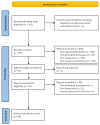Diagnosis, Severity, and Prognosis from Potential Biomarkers of COVID-19 in Urine: A Review of Clinical and Omics Results
- PMID: 39728505
- PMCID: PMC11678741
- DOI: 10.3390/metabo14120724
Diagnosis, Severity, and Prognosis from Potential Biomarkers of COVID-19 in Urine: A Review of Clinical and Omics Results
Abstract
The COVID-19 pandemic, caused by the SARS-CoV-2 virus, has spurred an extraordinary scientific effort to better understand the disease's pathophysiology and develop diagnostic and prognostic tools to guide more precise and effective clinical management. Among the biological samples analyzed for biomarker identification, urine stands out due to its low risk of infection, non-invasive collection, and suitability for frequent, large-volume sampling. Integrating data from omics studies with standard biochemical analyses offers a deeper and more comprehensive understanding of COVID-19. This review aims to provide a detailed summary of studies published to date that have applied omics and clinical analyses on urine samples to identify potential biomarkers for COVID-19. In July 2024, an advanced search was conducted in Web of Science using the query: "covid* (Topic) AND urine (Topic) AND metabol* (Topic)". The search included results published up to 14 October 2024. The studies retrieved from this digital search were evaluated through a two-step screening process: first by reviewing titles and abstracts for eligibility, and then by retrieving and assessing the full texts of articles that met the specific criteria. The initial search retrieved 913 studies, of which 45 articles were ultimately included in this review. The most robust biomarkers identified include kynurenine, neopterin, total proteins, red blood cells, ACE2, citric acid, ketone bodies, hypoxanthine, amino acids, and glucose. The biological causes underlying these alterations reflect the multisystemic impact of COVID-19, highlighting key processes such as systemic inflammation, renal dysfunction, critical hypoxia, and metabolic stress.
Keywords: COVID-19; biomarkers; clinical; diagnosis; omics; prognosis; severity; urine.
Conflict of interest statement
The authors declare no conflicts of interest. The funders had no role in the design of the study; in the collection, analyses, or interpretation of data; in the writing of the manuscript; or in the decision to publish the results.
Figures


Similar articles
-
Testing the efficacy and safety of BIO101, for the prevention of respiratory deterioration, in patients with COVID-19 pneumonia (COVA study): a structured summary of a study protocol for a randomised controlled trial.Trials. 2021 Jan 11;22(1):42. doi: 10.1186/s13063-020-04998-5. Trials. 2021. PMID: 33430924 Free PMC article.
-
Safety and efficacy assessment of allogeneic human dental pulp stem cells to treat patients with severe COVID-19: structured summary of a study protocol for a randomized controlled trial (Phase I / II).Trials. 2020 Jun 12;21(1):520. doi: 10.1186/s13063-020-04380-5. Trials. 2020. PMID: 32532356 Free PMC article.
-
Dietary glycation compounds - implications for human health.Crit Rev Toxicol. 2024 Sep;54(8):485-617. doi: 10.1080/10408444.2024.2362985. Epub 2024 Aug 16. Crit Rev Toxicol. 2024. PMID: 39150724
-
Neopterin and kynurenine in serum and urine as prognostic biomarkers in hospitalized patients with delta and omicron variant SARS-CoV-2 infection.Clin Chem Lab Med. 2023 Jun 9;61(11):2053-2064. doi: 10.1515/cclm-2023-0381. Print 2023 Oct 26. Clin Chem Lab Med. 2023. PMID: 37285602
-
Total serum bile acids or serum bile acid profile, or both, for the diagnosis of intrahepatic cholestasis of pregnancy.Cochrane Database Syst Rev. 2019 Jul 5;7(7):CD012546. doi: 10.1002/14651858.CD012546.pub2. Cochrane Database Syst Rev. 2019. PMID: 31283001 Free PMC article.
References
-
- Ochani R., Asad A., Yasmin F., Shaikh S., Khalid H., Batra S., Sohail M., Mahmood S., Ochani R., Hussham Arshad M., et al. COVID-19 pandemic: From origins to outcomes. A comprehensive review of viral pathogenesis, clinical manifestations, diagnostic evaluation, and management. Infez. Med. 2021;29:20–36. - PubMed
-
- Nakayama R., Bunya N., Tagami T., Hayakawa M., Yamakawa K., Endo A., Ogura T., Hirayama A., Yasunaga H., Uemura S., et al. Associated organs and system with COVID-19 death with information of organ support: A multicenter observational study. BMC Infect. Dis. 2023;23:814. doi: 10.1186/s12879-023-08817-5. - DOI - PMC - PubMed
Publication types
LinkOut - more resources
Full Text Sources
Miscellaneous

